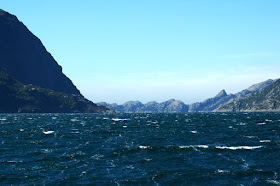Losneosen, near the entrance to Sognefjord. Down below is the threshold, where the bottom of the fjord rapidly rises from about -1200m to about -200m on the approach to the outer coast
This is a good explanation from Wikipedia for what goes on in the deepest parts of closed toughs where overdeepening happens on a spectacular scale.
https://en.wikipedia.org/wiki/Overdeepening
"Analytic glacial erosion models suggest that ice flows passing through constrained spaces such as mountain passes produced enhanced erosion beneath thicker, faster ice flows, which deepens the channel below areas both upstream and downstream. The underlying physical phenomena is that erosion increases with the rate of ice discharge. Although this simplifies complex relationships among time-varying climates, ice sheet behaviors and bed characteristics, it is based on the general recognition that enhanced ice discharges typically increase the erosion rate. This is because the basal sliding rate and the erosion rate are interrelated and driven by the same variables: the ice thickness, the underlying bed slope, the overlying glacial slope and the basal temperature. As a result, the modeled fjords are deepest through the narrowest channels (i.e., regions with the highest surrounding highest topography). This corresponds with actual physical observations of fjords.[16]"
This is the explanation, from the same web site, fo the processes that operate on the reverse or adverse slope, across which bast amounts of eroded debris are carried uphill:
Adverse slope zone
"As it continues to flow and begins to rise up the adverse slope beneath temperate (or "warm-based") glaciers, the pressure decreases and frazil ice accretes in the basal ice. The sediment load carried by the water will be entrained in the accreted ice.[17] At the point in the glacier where the ice is accreting on the adverse slope near the glacier terminus, ablation of the upper surface ice exceeds (for recently observed glaciers) the rate of accretion at the bottom. The net effect is that for a glacier which retains its overall shape, glacier mass will be transferred by water flow to accrete new ice, by sediment transport into meters thick layers observed in the accretion zone, and by movement of the total ice mass to restore the ice lost to ablation.[10]
The sediment-transport capacity and sediment load in subglacial stream glaciers in which the water is not supercooled and for a glacier far into the supercooling regime vary significantly. When a moraine or moraine shoal (bedrock) has developed, the overdeepening terminates in a growing sediment-floored feature. When there is a significant increase in the elevation on the adverse slope, ice grows from supercooling of streams flowing up the overly steep face of the moraine shoal causes transport capacity to drop below load delivered, producing deposition to fill the adverse face of the overdeepening back towards the supercooling threshold. When the flow is able to remove all the sediment delivered but not able to erode bedrock as rapidly as the upstream glacier erodes bedrock in the overdeepened area, then the ice forms on bedrock, and subglacial erosion lowers the glacier bed in the overdeepened region while leaving a bedrock sill.[8]"
I have left the hyperlinks in there -- I hope they will work.......
I'm a bit less convinced by this somewhat complex explanation -- and especially by the role given to frazil ice or slush on the glacier bed. I understand the point that ablation may suddenly become so rapid on the glacier surface that it exceeds the rate of accretion on the glacier bed, and that diffluence or snout spreading can also cause a loss of energy in a fjord glacier -- so that the forward movement of the glacier cannot any longer be maintained. But if a large volume of ice is passing over a sill, we have a situation analagous to toothpaste being squeezed out of a tube, with accelerated flow. In that case, why do we not also see accelerated erosion, and why does the glacier not seek to get rid of the sill or threshold?
All very intriguing -- at least, it is for glaciologists and glacial geomorphologists.......

No comments:
Post a Comment
Please leave your message here